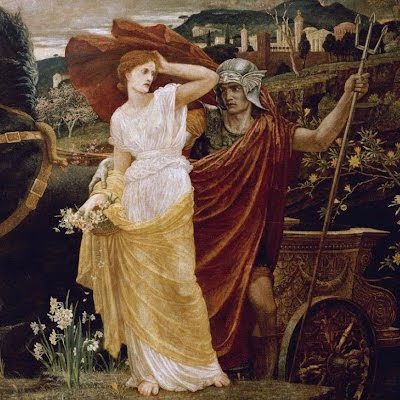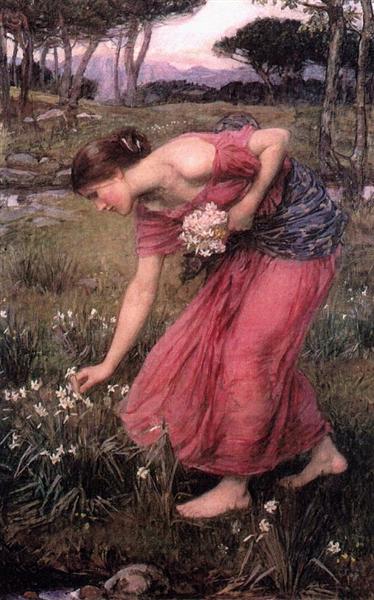The Fate of Persephone
Walter Crane
c. 1877
Oil on Canvas

Many other artists have painted Persephone. I’ve included a few other depictions below.
For information on the very interesting provenance of this painting, jump to this section below.
Rosetti's Proserpina
English artist and poet Dante Gabriel Rossetti painted at least eight separate versions of Persephone starting in 1874 (using the Latin form of her name, Proserpina).
He completed the eighth and final version in 1882, the year of his death.
You can see three versions below.
Persephone by Other Artists
Provenance of The Fate of Persephone by Walter Crane
Art Terms
Provenance (noun) – the history of ownership of a valued object or work of art or literature
Karl Haberstock, a Berlin art dealer who trafficked in Nazi-looted art for Adolf Hitler and Nazi leader Hermann Göring, purchased the The Fate of Persephone for $100 in 1923 and took it to the U.S. where it was purchased by a Professor at Yale University.
In 1935 the Professor lent it to a school in Connecticut. The picture languished at the school until it was recently recognized by a ten-year-old student. The painting was then returned to the owner’s two surviving daughters.
However, getting back to Karl Haberstock – At the end of World War II, Haberstock was arrested for his art-looting activities for the Nazis, but because he testified against Göring at the Nuremberg Trials, he was released. He died in 1956.
The extent of Haberstock’s role in trafficking looted artworks during WWII was not generally known until the end of the Twentieth Century due to the opening of previously classified files.
Today, Haberstock is known as “one of the most notorious Nazi art dealers.”
The Fate of Persephone recently sold at Christie’s Auction house for $485,000 in 2002.
Nazi-Looted Art During WWII
& The Monuments Men
Hitler illegally amassed a huge amount of artwork during WWII for a museum that he intended to build, which he called the Führermuseum. He hid most of the irreplaceable artwork in salt mines in and around Germany to protect the art pieces from Allied bombing.
A group of Allied soldiers called The Monuments Men were charged with the task of finding all of the famous artwork that Hitler had stolen throughout Europe.
American soldiers found more than 6,500 famous works of art at the end of the war.
Stolen artworks included:
- Mona Lisa by DaVinci
- The Night Watch by Rembrandt
- Ghent Altarpiece by Jan van Eyck
- Madonna of Bruges statue by Michaelangelo
- Portrait of Adele Bloch-Bauer (also known as The Lady in Gold) by Gustav Klimt
as well as other works by Vermeer, Van Gogh, Pissarro, Manet, Raphael, and many more. Many artworks are still missing.
You can read more about this topic in an article called The True Story of the Monuments Men by Smithsonian Magazine, at the Monuments Men and Women Foundation website, or read a summary on Wikipedia.
The story of The Monuments Men was also made into a movie by the same name in 2014 starring George Clooney and Matt Damon (see video below).
If you’d like to dive into this fascinating history of WWII, you can read more about Nazi Plunder on Wikipedia here.
And here are some books on the subject:
- The Monuments Men: Allied Heroes, Nazi Thieves and the Greatest Treasure Hunt in History by Robert M. Edsel
- The Thefts of the Mona Lisa: On Stealing the World’s Most Famous Painting by Noah Charney
- The Book Smugglers: Partisans, Poets, and the Race to Save Jewish Treasures from the Nazis by David E. Fishman
- Hitler’s Last Hostages: Looted Art and the Soul of the Third Reich by Mary M. Lane
- Plundering Beauty: A History of Art Crime During War by Arthur Tompkins
- The Rape of Europa: The Fate of Europe’s Treasures in the Third Reich and the Second World War by Lynn H. Nicholas
- Witnessing the Robbing of the Jews: A Photographic Album, Paris, 1940-1944 by Sarah Gensburger
- The Lady in Gold: The Extraordinary Tale of Gustav Klimt’s Masterpiece, Portrait of Adele Bloch-Bauer by Anne-Marie O’Connor





